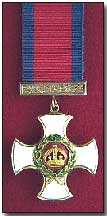Encyclopedia - Distinguished Service Order
 The British Distinguished
Service Order medal, instituted on 9 November 1886 during Queen Victoria's
reign, was awarded to officers who had performed distinguished or
meritorious service during wartime, typically during actual combat against
the enemy.
The British Distinguished
Service Order medal, instituted on 9 November 1886 during Queen Victoria's
reign, was awarded to officers who had performed distinguished or
meritorious service during wartime, typically during actual combat against
the enemy.
To qualify the officer concerned also had to have been specifically Mentioned in Despatches by the Commander-in-Chief (until 1943). The medal was ordinarily awarded to officers from Lieutenant-Colonel and upwards, although there are numerous instances of Majors receiving the award, although it was seldom given to more junior officers.
Recipients of the Distinguished Service Order were entitled to use the letters DSO after their name. In terms of prestige the medal was regarded as somewhat lesser than a Victoria Cross. Indeed in cases where acts of merit were not judged quite sufficient for the award of a VC, or could not be sufficiently corroborated, the DSO was instead awarded.
Although the DSO was in fact also awarded for acts not directly involving actual combat with the enemy during the first two and a half years of the war, from 1 January 1917 officers were issued guidance stating that the award was reserved for distinguished conduct under enemy fire.
A Bar (of plain gold with an imperial crown in the centre) could be additionally awarded as a way of formally recognising further acts of merit. The medal itself was of silver gilt (since 1889, gold prior to this date), 55mm in height and 41.5mm in width.
8,981 DSOs were awarded during the First World War. Each award was announced in the London Gazette together with its accompanying citation.
A "blimp" was a word applied to an observation balloon.
- Did you know?
